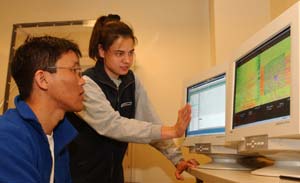Here you can find a summary of innovations in the fields of information and data processing and up-to-date developments on IT equipment and hardware.
This area covers topics such as IT services, IT architectures, IT management and telecommunications.

Researchers at Purdue University are making it easier to read life’s genetic blueprint.
They have precisely placed strands of DNA on a silicon chip and then stretched out the strands so that their encoded information might be read more clearly, two steps critical to possibly using DNA for future electronic devices and computers.
Findings about the research are detailed in a paper posted online this month and will appear in an upcoming issue of the journal Advanced Materials.

Monitoring patients once they have left hospital is a vital part of follow-up care, but many small clinics and hospitals find it difficult to provide.
EUREKA’s MADISON project has developed a new computer package which will give small institutions the technical means to improve follow-up of outpatients by accessing the servers of larger hospitals. Using the new software, they can access and use the data held in the larger institutions to better follow patients’ medical and nutritional care

Designers of semiconductor devices are like downhill skiers – they thrive on speed. And achieving speed in the semiconductor business is all about the stuff you start with. While silicon is still the mainstay of the industry, circuit designers also would like to put materials like gallium nitride and silicon carbide into wider use. Such advanced semiconductor materials can operate at higher voltages and provide faster switching speeds, an important characteristic in determining how fast a semiconduct

Collaborative project promises new approach to battling fires
Someday fire fighters will be able to manage wildfires by computer.
Rochester Institute of Technology recently won a $300,000 grant from the National Science Foundation to translate remote-sensing data about wildfires into real-time “mini-movies” that fire managers can download on laptop computers at the scene of a blaze. The model and visualization will predict the fire’s behavior for the following hour.

For the first time a material now exists that is not only a semiconductor but also exhibits exploitable magnetic properties at room temperature. Researchers at the Royal Institute of Technology (KTH) in Stockholm, Sweden, have taken the lead in an international race to find the technology of tomorrow.
Today’s computers process information using semiconductor chips and store it on magnetic discs. Tomorrow’s technology may mean that these parts merge into a single chip. This is based on the so

Pursuing commercialization of technologies spawned by its highly successful µChemLab(tm) project, Sandia National Laboratories is actively soliciting industry partners to license, manufacture, and sell a unique suite of microfluidic connection products.
Two distinct portfolios are being offered for licensing: The CapTite(tm) collection of capillary fittings, which is based on an exclusive one-piece ferrule; and the Chip-Tite(tm) series of manifolds and interconnects, which is fully compati